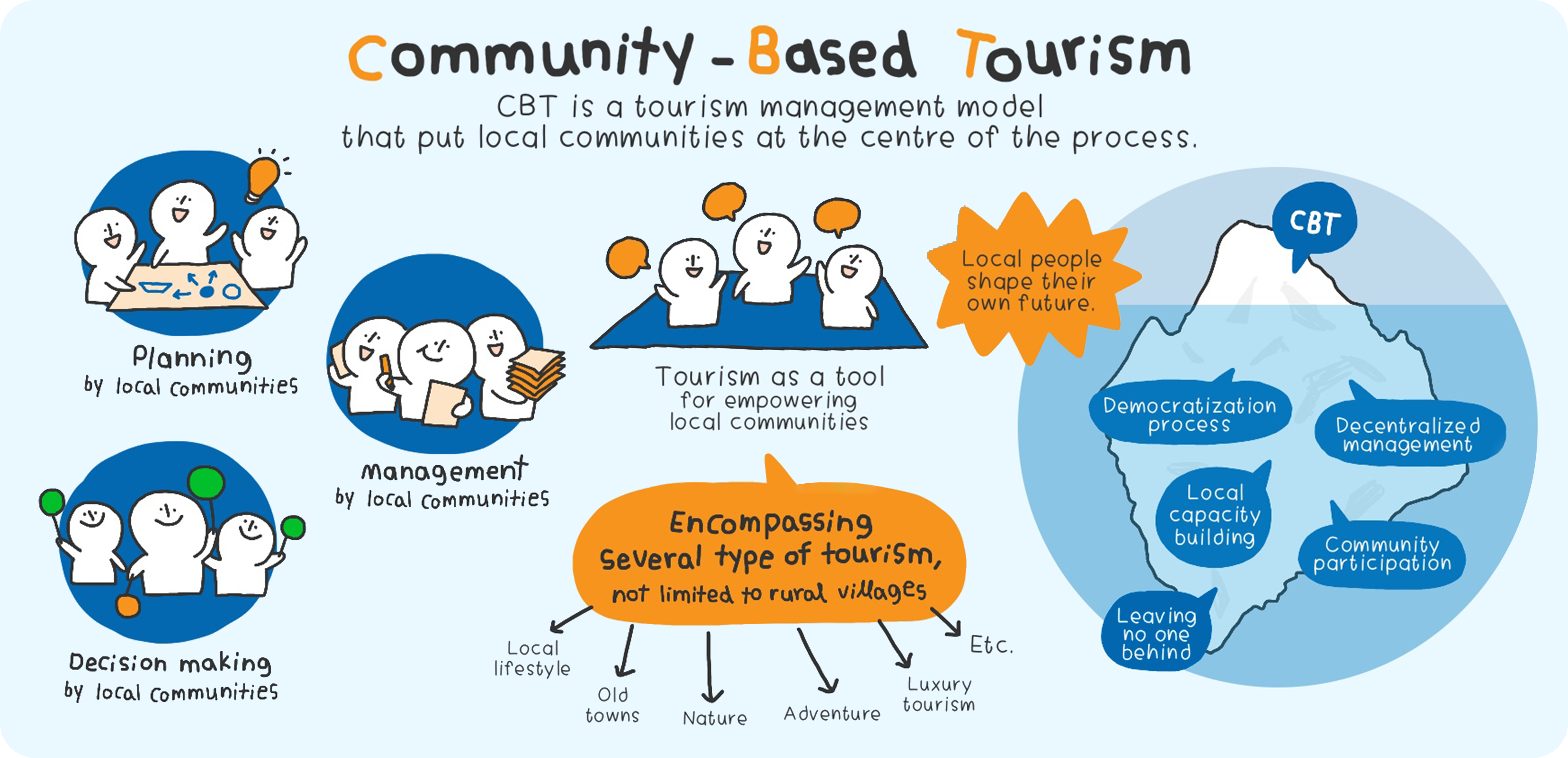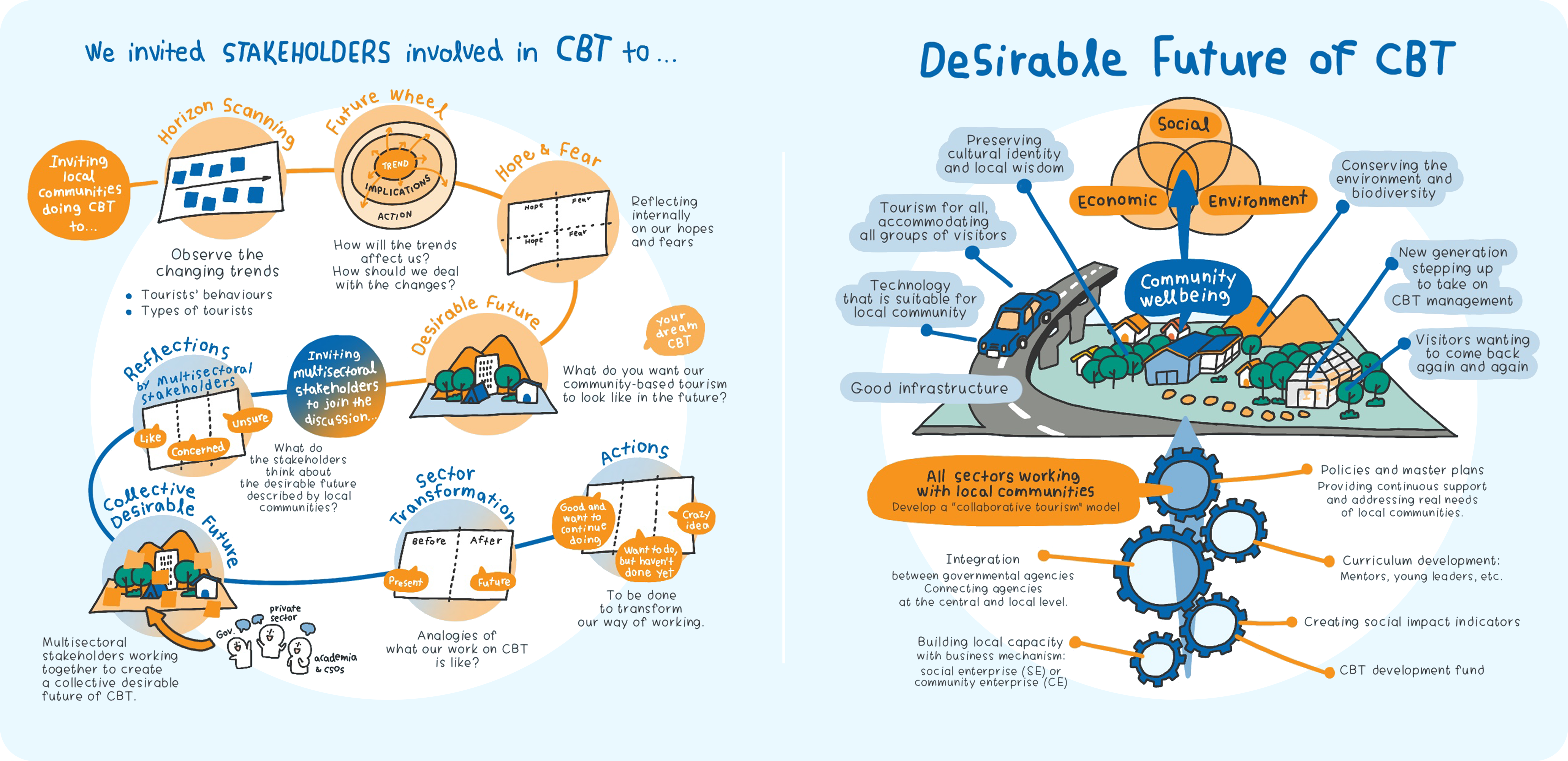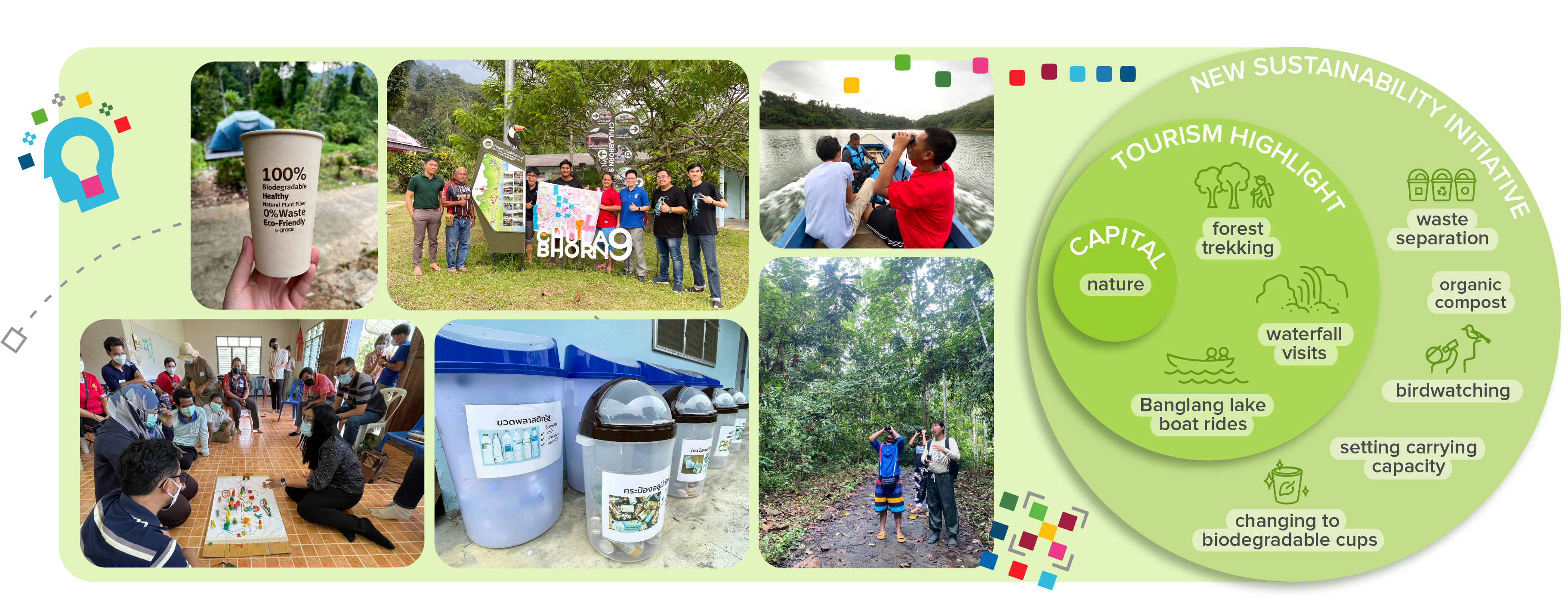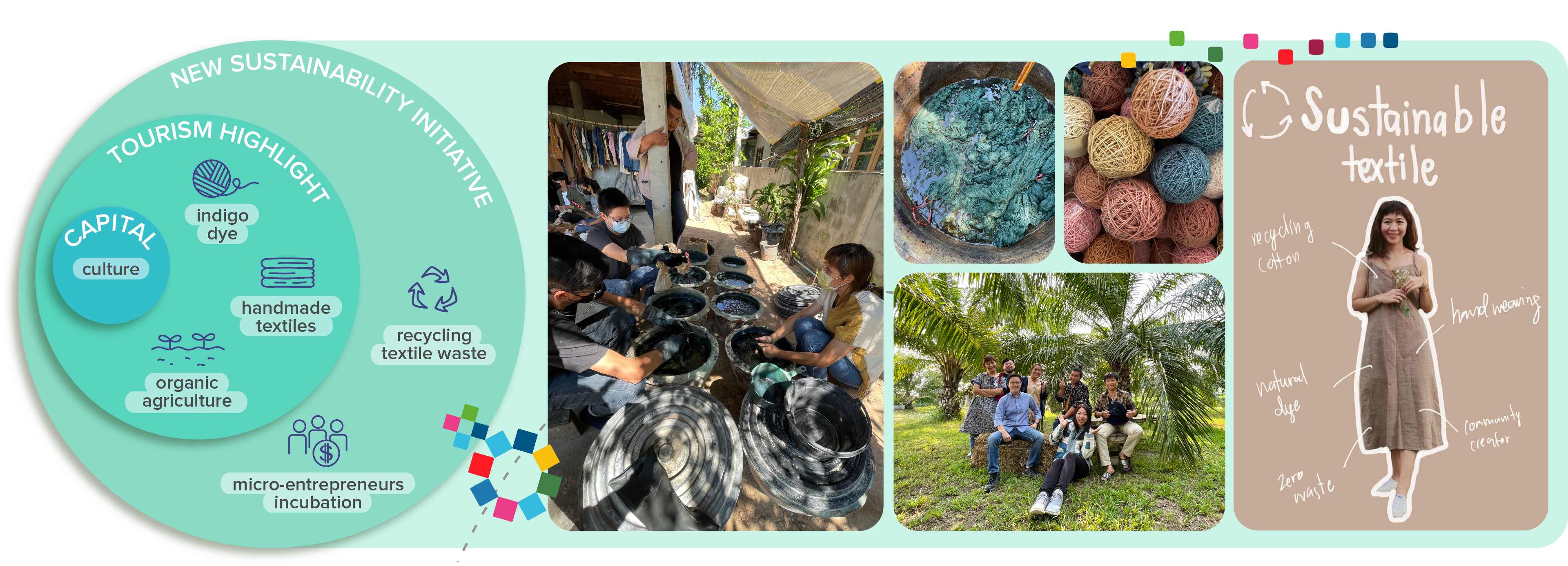Community-Based Tourism: Empowering Local Champions for Sustainable Tourism in Thailand
November 6, 2022
Thailand is among the world's top tourist destinations. The country’s diverse geographical settings and rich cultural capital provide a vast variety of tourism experiences from relaxing by beautiful sandy beaches of the South to exploring lush green forests of the mountainous North and enjoying local cultures in the Northeast. In 2019, Thailand welcomed a record high of 40 million visitors. For this reason, tourism is a major driver of Thailand’s economic development, providing around 20% of the national GDP and employing over 4.2 million people (11% of total employment). However, Thailand’s tourism industry is not without negative side effects. Unsustainable management of tourism has proven to cause environmental degradation and biodiversity loss as well as fuel uneven economic development. Oftentimes, economic benefits from tourism fall into the hands of large tour operators and investors from the outside while local communities gain minimum economic benefit and are left to suffer many social and environmental drawbacks.
While the COVID-19 pandemic has caused a major setback to the tourism industry, it also provides an opportunity for Thailand to rethink its tourism. Sustainable and resilient tourism has become a key theme for the country and is now one of UNDP Thailand’s focus areas. UNDP Accelerator Lab Thailand seized this opportunity to embark on a journey to support the growing momentum for sustainable tourism by contributing innovative approaches to the redefinition of the country’s tourism industry, specifically from the angle of community-based tourism.

Why community-based tourism?
Emerged in Thailand in the 1990s, ‘community-based tourism (CBT)’ proposes the idea of ‘tourism by the local people for the local people’. It is one of the solutions for sustainable tourism because, under this framework, local people are the key decision-makers of their tourism development and the ones to fully benefit from it. Being long-term residents of the areas, local communities are more incentivised to balance economic growth and socio-cultural and environmental impacts caused by tourism activities. At the end of the day, it is their home. However, it is crucial to clear the misconception that CBT refers to ‘village tourism,’ limited only to certain styles of tourism that take place in rural areas. CBT is a tourism management model that puts local communities at the center of the process and can encompass diverse tourism styles from rural tourism to urban tourism, nature tourism, or even luxury tourism. Essentially, CBT is about community empowerment as it is a process in which local people are empowered to uplift their own livelihood.
The pandemic has posed both challenges and opportunities for CBT. International travel restrictions caused a major drop in foreign visitors which used to make up a significant portion of visitors for CBT. Local communities needed to adjust themselves to the domestic tourism market and diversify their offers e.g. community products beyond tourism activities. On the other hand, the pandemic has shaped new tourist behaviours- traveling in smaller groups, choosing less crowded destinations, escaping to nature, and searching for unique experiences and activities for well-being, among others. Many of these new preferences match very well with what CBT can offer and can potentially pave way for a golden age of CBT. Moreover, pandemic-induced lockdowns in major cities led to a reverse in rural-urban migration. Many people working in the cities returned to their hometowns during the lockdown and some sought to find livelihood options at home. CBT provides an alternative and in turn benefits from increased human resources- the skilled workforce who have gained skills and exposure from their time working in the cities. All in all, it is an important time for CBT to take the next step to ensure its thrivability in this rapidly changing world.
Making sense of CBT and contemplating on the way forward
As a starting point, national-level workshops were co-organized by UNDP Accelerator Lab Thailand, Thailand Policy Lab, the Designated Areas for Sustainable Tourism Administration (DASTA), and Local Alike (one of Thailand’s leading social enterprises working on CBT). Representatives from local communities, relevant governmental agencies, the private sector, civil society organizations, and academia exchanged views on trends and weak signals affecting CBT as well as discussed the desirable future and way forward. A few interesting points from the exercise include:
- CBT can go beyond leisure tourism and provide learning experiences for visitors, for example community-based environmental conservation and waste management and tap into opportunities from the rise of corporate social responsibility (CSR) and Thailand’s Bio-Circular-Green (BCG) Economy Model of the government.
- Communities need to build the next generation of CBT leaders. Involvement and incentives for the new generation are key for successful engagement and transition.
- Planning and decision-making should be a bottom-up and collaborative process between the government and local communities to avoid projects which do not fit local contexts or serve the real needs of stakeholders. For instance, many tourism applications were created but abandoned.
- Multisectoral support is crucial for CBT development e.g. support from the private sector on digital transformation, academia on CBT-related curriculum for young leaders, etc.
- Funding mechanisms must be further developed e.g. shifting from an informal arrangement to a social enterprise, setting up CBT development funds, etc.

While the discussion revealed multiple areas for development, capacity building for local communities stood out as one of the prerequisites for success. Since local communities are the main drivers of CBT, they must be equipped with frameworks and tools that will enable them to flourish in the rapidly changing world. Existing capacity-building initiatives have been fairly successful in supporting local communities to begin their CBT journey, often focusing on building the foundation and taking a short/medium-term view. While such emphasis is essential, it might not be sufficient any longer. Especially once local communities manage to set up the basics of their CBT, they also need to start thinking about sustainability and being anticipatory. As a result, the Lab identified this as our area of work: how local communities can make their CBT become more sustainable.
Learnings with the locals
UNDP Accelerator Lab Thailand in collaboration with Local Alike joined hands with two pilot communities to start our learning journey. Social innovation tools were applied to invite local stakeholders to reflect on the becoming of their CBT and look forward through the lens of sustainability. Given the different nature of each community, the discussions and sustainability initiatives took on different directions. However, one commonality revealed itself. Community is never homogeneous; CBT development is an area of convergence for different groups to interact and build momentum toward sustainability. To elaborate, let’s take a closer look at each of the pilot communities…
Chulabhorn Pattana 9 community: A case of nature-based tourism from the South
As a neighbour of the world-famous Hala-Bala Wildlife Sanctuary, Chulabhorn Pattana 9 community of Yala province in Southern Thailand has attracted many nature lovers; some visited the village just to enjoy the serenity and beauty of the natural environment while others were excited by the rich biodiversity of the Hala-Bala Forest, not to mention the village’s charming cultural heritage from their Community Malaya time. The village is familiar with receiving visitors as they have been welcoming relatives and friends from Malaysia and Singapore (legacy of Community Malaya time) for decades. Eight years ago, the concept of CBT was introduced, and the new generation stepped up to lead CBT management. The intergenerational difference is reflected in the different views on tourism management- one hoping to increase the number of visitors while another seeking to keep the delicate balance. The new generation realizes that their main target group is nature lovers. Thus, nature is the main capital for their CBT and its conservation is of paramount importance. Hence, the discussion about limiting the number of visitors with consideration of the area’s carrying capacity was very well received by the CBT management team.
CBT at Chulabhorn Pattana 9 does not only aim to mitigate the negative effects of tourism activities but also inspires positive changes in the local community. In many cases, tourism may have resulted in waste management problems. On the contrary, for Chulabhorn Pattana 9 community, the visitors are the ones demanding that waste in the village needs to be better managed. Hearing these comments, the CBT management team was eager to start a waste management initiative with support from the Lab and Local Alike. Waste separation and organic compost-making have been pioneered by the CBT group and will be shared with fellow villagers to inspire more people to join the effort.
In addition, the CBT management team sought to further develop tourism activities that highlight the value of biodiversity and incentivize conservation. Birdwatching was identified as a viable option. Interestingly, apart from our support, birdwatching was born out of collaboration with a visitor who happens to be a bird expert, an ex-member of the Bird Conservation Society of Thailand. Feeling that Chulabhorn Pattana 9 is more than a touristic destination to him, this bird expert saw the potential and was more than willing to help provide training on birdwatching to local guides. Chulabhorn Pattana 9 is able to shift from selling their services to ‘tourists’ to building relationships with ‘visitors’, some of whom have become ‘friends’ to co-create a sustainable future for their CBT.

Nong San community: Local life and craft in the Northeast
Nong San community of Sakon Nakhon province in the Northeast of Thailand is famous for its indigo dye handicrafts. Traditional knowledge on indigo dye has been passed on from generation to generation at Nong San village. When combined with the skills of a new generation artist, Pornpimon Mingmitmee, this cultural capital becomes the starting point of Nong San CBT. Visitors, both craft lovers and chillax tourists, enjoy the simple slow life and recharge themselves with natural dye crafts, organic agriculture, and the beauty in the local lifestyle. However, the early days of Nong San CBT were not all easy. The community did not believe that CBT was viable at first, so Pornpimon had to start small and gradually showed other people the success to inspire more support from within the village and nearby community. Furthermore, with the COVID-19-induced lockdown, villagers who used to work in other cities returned to the village and joined force to expand Nong San CBT. However, unlike Chulabhorn Pattana 9 case, Nong San CBT opts for a more decentralized model where each member acts as an independent micro-entrepreneur and loosely connects to provide tour packages for visitors. Therefore, the work here was about business incubation for female micro-entrepreneurs to enhance the distribution of benefits from CBT among the local people. Entrepreneurial skills, including digital marketing, were provided to interested locals.
Circularity is another theme as Pornpimon has been trying to manage waste materials from textile crafts production e.g. left-over threads and fabric scraps. Drawing inspiration from India, the initial idea was to turn textile waste into paper. Local knowledge in Thailand provides a technique for turning natural fibers into handmade paper. Yet, from the prototyping phase, cotton textile waste has proven to be more difficult to handle than other fibers. An alternative was presented as Pornpimon connected with a company working on recycled textiles. The idea is to compile textile waste from the local community, turn it into recycled fabrics, and send it back to the community as raw materials for new products. At the time of writing, the discussion is still ongoing to develop a suitable model of collaboration. This case demonstrates the power of cross-sectoral collaboration in driving CBT toward sustainability.

Sharing our experiences
Through the working process with our partners, UNDP Accelerator Lab Thailand was able to learn about CBT development as well as share our social innovation tools with key change agents like Local Alike and relevant governmental agencies. Realizing the value of these tools in facilitating processes towards sustainability and resilience, the Lab together with Local Alike co-produced the Community-Based Tourism Social Innovation Playbook to share with others the experience of Thailand. The Playbook emphasized that social innovation process is not linear. While the tools are categorized into three groups (making sense of the past and present; looking forward to the future; and taking actions), users can always jump back and forth between each category of tools to fill the gaps of knowledge as they surface. Case studies from our work with Chulabhorn Pattana 9 and Nong San communities demonstrate this non-linear journey as well as the fact that no two communities are alike; thus, the social innovation tools must be ultilized in consideration of specific local contexts.
In addition to the publication, the Accelerator Lab Thailand will be working with the Accelerator Lab Bangladesh on CBT development in their context. Follow our next blog to see how Thailand’s experiences can be adapted and what lessons we will learn on the journey to transform tourism into a vehicle for sustainable development.

 Locations
Locations